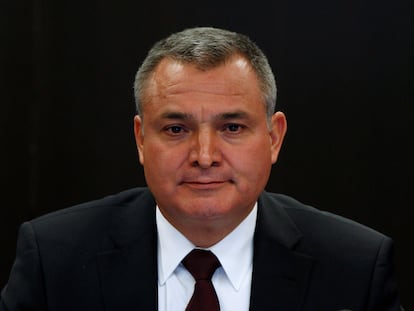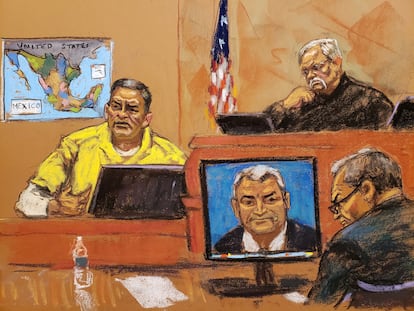Genaro García Luna’s defense alleges a ‘plot’ against Mexico’s former drug czar and demands a new trial in New York
Lawyers for the former Mexican official, imprisoned in the U.S. for drug trafficking and organized crime, say they have new evidence that exonerates their client

Genaro García Luna wants to sit in the dock once again. The defense for Mexico’s former drug czar filed a motion this Friday to request a new trial for their client in New York. His lawyers claim they have had access to new evidence that exonerates Felipe Calderon’s Public Security Secretary, the highest-ranking former Mexican official ever to be tried in a U.S. court. The former Federal Police chief was found guilty last February of drug trafficking, organized crime and false statements. Judge Brian Cogan, the same judge who convicted Joaquín “El Chapo” Guzmán, must decide whether to grant the request of García Luna’s lawyers or proceed to sentence him next year.
“Since the guilty verdict, new evidence has come to light establishing that the case against Genaro García Luna was marred by multiple Brady violations and false testimony by critical witnesses,” reads a document presented by the defense. The new evidence in possession of the lawyers includes testimonies of his close associates; official agendas to establish where he was at key moments of the case; trust control tests he underwent when he was an official and collaborated with his U.S. counterparts; personal correspondence; detailed reports on the Pegasus espionage program, and other documents, which according to his legal representatives, prove that there was an alleged plot to frame him led by the Attorney General’s Office.
The defense also claims that the U.S. Attorney’s Office for the Eastern District of New York failed to turn over evidence that could be used by their client to defend himself, which is what they refer to as Brady violations. They also allege that at least two witnesses who testified against García Luna committed perjury: Héctor Villarreal Hernández, treasurer of former Coahuila governor Humberto Moreira, and Francisco Cañedo, a former ministerial agent. Villarreal Hernandez claimed during the trial that the former official paid bribes of 25 million pesos a month in kickbacks to the newspaper El Universal in exchange for favorable coverage. Cañedo claimed that he witnessed a meeting between García Luna and two notorious drug traffickers: Édgar Villarreal “La Barbie” and Arturo Beltrán Leyva, known as “El Barbas.” The former agent said that the ex-official was kidnapped by the Beltrán Leyva Cartel in October 2008.
Testimonies in the spotlight
Villarreal Hernandez said on the stand that García Luna asked Governor Moreira to introduce him to the owner of El Universal, Juan Francisco Ealy Ortiz, to set up a bribery scheme. He also substantiated that the former official was briefly kidnapped by members of the cartel belonging to the Beltrán Leyva family. The defense argues that García Luna and Ealy Ortiz knew each other long before 2009, when the witness said he helped create the bribery network, and presented photographs to show that they had “a close relationship.” They also presented a chart with almost twenty meetings between the official, the owner of the newspaper and several editors, and “negative” articles published by the newspaper to refute the idea that he received favorable coverage.
The defense asserts that the former Coahuila treasurer also lied about meetings he held with García Luna, but which do not appear in his calendar as an official, and about an alleged visit in early 2009 to the bunker created during García Luna’s administration, which was not inaugurated until the end of that year. In that visit, Villarreal Hernandez said that the former secretary showed him how the spy software Pegasus worked. García Luna’s legal representatives say that NSO Group, the Israeli company that sold the spying program, was not established until a year after the alleged demonstration and the offer for the Coahuila government to acquire it.
García Luna’s lawyers also accuse Agent Cañedo of lying about García Luna’s kidnapping in 2008 and say his testimony was part of a “political strategy” to discredit their client. They claim that the ex-official was at the Angeles Hospital in Mexico City accompanying his wife in surgery and present a bill for the hospital bill. They also cite the testimony of José Jorge Rincón, one of his bodyguards, stating that the security protocol required them to always take the toll highway when going to his weekend home in Jiutepec (Morelos) and not the free highway, where Cañedo says the meeting with the drug kingpins took place. And that of his private secretary, in which she states that she never saw Cañedo in the offices of the agency, where she said he worked.
The request for a new trial also claims that other key witnesses such as former Nayarit prosecutor Édgar Veytia, known as “El Diablo,” and Óscar Nava Valencia (”El Lobo”) communicated with contraband phones before the trial, contradicting the prosecution’s thesis that the witnesses gave statements to the same effect even though they had not seen each other in years or even met. This assertion comes from the testimony of an inmate at the Brooklyn Metropolitan Detention Center, who coincided in 2019 with Carlos Nava Valencia, alias “El Tigre” and brother of “El Lobo,” and who saw him communicate with him and Veytia, according to an affidavit. He also became close to Veytia as early as 2022, a year before the trial.
The alleged plot to frame García Luna
The document also states that members of Mexico’s Attorney General’s Office intercepted calls from Víctor Hugo Martínez Rocha, an imprisoned drug lord, which were sent to García Luna as a threat that he was being targeted since the end of 2009. The prisoner told his mother that “these people wanted to fuck García Luna” and were pressuring him with death threats to testify against him. Prosecutors allegedly wanted him to say that he and the ex-official met on a yacht, where he gave him a bribe for three million dollars from Joaquín “El Chapo” Guzmán.
For months, García Luna’s lawyers anticipated that they had had access to new materials that they had not been able to review while the trial was ongoing or that they had not received while the judicial process was underway. This evidence came from high-ranking U.S. and Mexican officials, as well as from people who had access to exculpatory documents, they explained. These are thousands of pages that they intend to introduce in case they get a new trial, but which have not been validated by the judge.
The defense requested a pair of postponements to build its legal strategy and try to overturn the guilty verdict after its client was accused of collaborating with the Sinaloa Cartel in exchange for million-dollar bribes for more than two decades. The prosecution must respond to the motion filed by the former official’s lawyers, then the defense will have a new opportunity to reply, and finally, Judge Cogan will have the last word. When asked about this, García Luna’s lawyers expect that it will be “weeks or even months” before they receive a definitive answer. There is no time frame for the judge to communicate his decision.
The defense’s request comes at the deadline granted by the judge and one day after Gloria García Luna, sister of the former official, was arrested in Cuernavaca in the case opened by Mexican authorities against the former secretary and his closest circle. His wife, Linda Cristina Pereyra, and at least four of García Luna’s siblings are accused of organized crime and operations with illicit resources. Oswaldo N, uncle of the former Federal Police chief, was also arrested in Puebla on the same charges. The proceedings in Mexico are unrelated and independent of the cases filed in the U.S. courts.
Sign up for our weekly newsletter to get more English-language news coverage from EL PAÍS USA Edition
Tu suscripción se está usando en otro dispositivo
¿Quieres añadir otro usuario a tu suscripción?
Si continúas leyendo en este dispositivo, no se podrá leer en el otro.
FlechaTu suscripción se está usando en otro dispositivo y solo puedes acceder a EL PAÍS desde un dispositivo a la vez.
Si quieres compartir tu cuenta, cambia tu suscripción a la modalidad Premium, así podrás añadir otro usuario. Cada uno accederá con su propia cuenta de email, lo que os permitirá personalizar vuestra experiencia en EL PAÍS.
¿Tienes una suscripción de empresa? Accede aquí para contratar más cuentas.
En el caso de no saber quién está usando tu cuenta, te recomendamos cambiar tu contraseña aquí.
Si decides continuar compartiendo tu cuenta, este mensaje se mostrará en tu dispositivo y en el de la otra persona que está usando tu cuenta de forma indefinida, afectando a tu experiencia de lectura. Puedes consultar aquí los términos y condiciones de la suscripción digital.
More information
Archived In
Últimas noticias
Most viewed
- Sinaloa Cartel war is taking its toll on Los Chapitos
- Oona Chaplin: ‘I told James Cameron that I was living in a treehouse and starting a permaculture project with a friend’
- Reinhard Genzel, Nobel laureate in physics: ‘One-minute videos will never give you the truth’
- Why the price of coffee has skyrocketed: from Brazilian plantations to specialty coffee houses
- Silver prices are going crazy: This is what’s fueling the rally











































